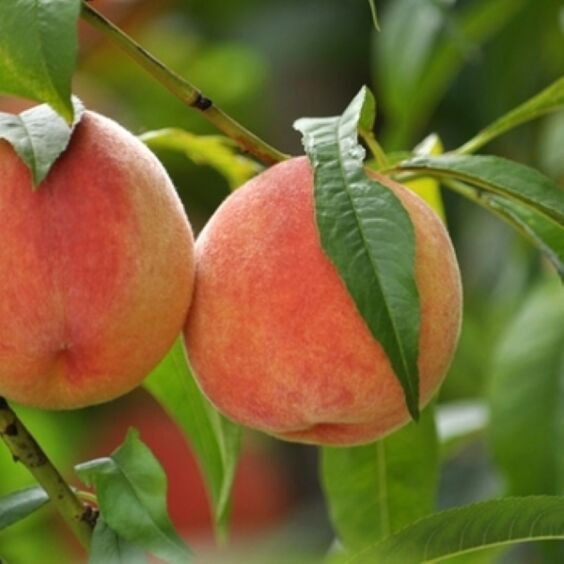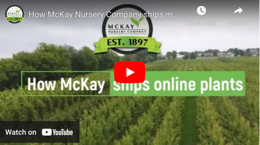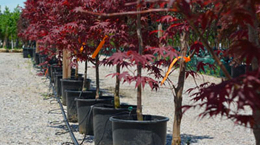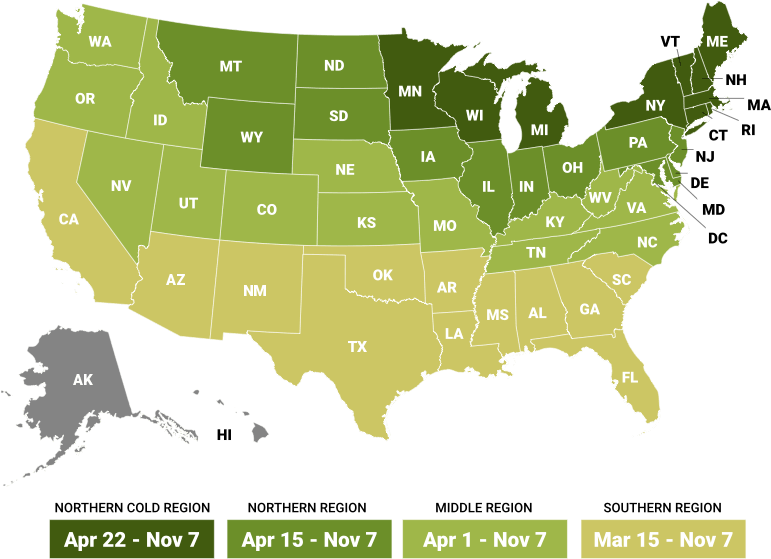
Growing zones
See Zone Map >Status: In stock
- Sun
Mature Plant Size (H x W): 12-15' x 12-15'
Bloom Season: Spring
- Attracts Bees
- Attracts Birds
- Walnut Toxicity Resistant
- Edible to People
- Attracts Butterflies
Planting & Care for Contender Peach Trees
Preparation
- The Contender Peach Tree is a cold hardy peach variety that is resistant to spring frosts.
- Peach Trees can be espalier trained if desired.
- Prune tree yearly and thin fruit to achieve the best fruit production. Pruning should occur in late winter or early spring when the tree is still dormant.
- The Contender Peach Tree is self-pollinating, but having another peach tree planted nearby can increase fruit production.
Opening Plant Material
- Bare Root - Cut open the bundle (top and roots are tied) and separate all the plants. Soak roots in buckets of water until planted. Each plant type will be labeled separately for identification. Do not expose the roots to sun. They should never dry out. Keep roots covered. All bare-root plants must be trimmed when planted.
- Containers - Completely saturate all container plants by putting in a larger container of water until stops bubbling, then remove the plant from the container.
- Grow Bags - Remove bag by using a utility knife to slit up the side and peel off the fabric exposing the soil and roots.
Planting Bare Root
- Plant Bare root in fall. A good indicator if you can still plant is if the ground is still workable you’re good to go. If a hard frost is expected be sure to hold off on planting.
- Dig a hole at least 6" wider and the same depth as the root mass. The crown or graft of the plant should be slightly higher than ground level where it was grown at the nursery.
- Trim off the broken roots and branches.
- Place fertilizer packets in hole (if purchased). Do not place other fertilizers in the planting hole. *Use Our Recommended Fertilizer.
- Spread the roots and fill halfway with soil, then water until soil settles completely saturating the soil and planting pit.
- Re-adjust plant and fill the hole with the rest of the soil.
- Back fill the balance of the soil and water well.
Planting containers
- Peach trees can be planted in March, April October or November.
- Dig a hole no deeper than the depth of the container and 6" or more wider on the sides.
- Slide plant from pot by tapping on the bottom of the pot.
- With shovel or knife trim bottom 2" off of the root ball for plants in plastic containers.
- Rotate the plant to the proper position. Never lift or move plants by the tops.
- Place the root ball in the hole.
- Adjust the plant height so the root crown is slightly higher than the ground.
- Place fertilizer packets into the bottom of the hole (if purchased). *Use Our Recommended Fertilizer
- Back-fill the hole with soil, making sure the top of the root ball is visible and slightly higher than the soil around it.
- Firm the soil around the plant. Water well to settle soil around the root ball.
- Water frequently when newly planted.
Planting Grow Bags
- Peach trees can be planted in March, April October or November.
- Plant the root ball just like you would a container plant. No trimming of roots is necessary for grow bags.
- With shovel or knife trim bottom 2" off of the root ball for plants in plastic containers.
- Rotate the plant to the proper position. Never lift or move plants by the tops.
- Place the root ball in the hole.
Pruning - After Planting
- Bare Root - Prune ALL bare root plants to reduce transplant shock and ensure success. Pruning should occur either before or as soon after planting as possible. All pruning should be done with a sharp pruning shears.
- Container & Grow Bags - Although it is not essential for container plants to be pruned after planting, a light pruning to remove any broken branches during shipment and improve shape will help the looks of your new planting.
Pruning - Through-out the Season
- Plan to prune your peach trees every year during their dormant season. In Zone 6 and north, you should wait until late winter.
- First dormant season (a year after you plant the tree): Remove the central leader and direct the tree growth toward three or four strong scaffolds. Choose branches that are evenly distributed around the trunk.
- Second dormant season: Prune away fast-growing new shoots but leave twig growth, which will be the fruit-bearing wood (on most peach trees).
- Third dormant season: Prune off any broken limbs or crossing branches, but don’t do any more major pruning until the tree has produced a good-sized crop.
- Mature-tree pruning: Once the basic shape of your peach tree has been established, make your pruning decisions in line with which branches are bearing fruit.
- Prune back each of last year’s stems to half its length.
Watering - After Planting
- Plants typically take approximately 6 weeks to establish new roots in your soil. During this period, water plants as often as every 2-4 days at the start and at least a minimum of once per week.
- Beyond the 6 week establishment period, water once per week, unless rains occur.
- Stick your finger into the soil around 3” to check soil moisture.
Watering - Through-out the Season
- After the first season, plants should only be watered during extended periods without rain.
- How do you know if your plants need water? The easiest way to tell is to touch the soil around the roots. If it is moist, there is no need to water. If it is dry, give it a good soaking with the hose end (no nozzle) watering the soil only, not the leaves.
- Stick your finger into the soil around 3” to check soil moisture.
Planting & Handling Help
Download our Planting and Handling Guide below to plan for a successful arrival and install of your plants. Be sure to water all plants as soon as they arrive and every day until you’re ready to plant. Keep any bare root bundles in a shady, cool spot with the roots covered at all times.


Learn More
Watch our videos on handling bare root plants, how your order is prepared for shipment and more.


Plant Sizing
What is the difference between Containers, Grow Bags, Bare Root, and Balled & Burlap (B&B)?
Shipping Times


Our FedEx and local shipping times depend on two factors, one is by the region and the second is the type of product being shipped. For example, small fruits are only shipped in spring, but majority of our perennials are shipped from spring until fall. Keep in mind the dates below act as a general guide. Due to unpredictable weather, staffing, inventory and industry demands these timelines can change. Therefore, we cannot guarantee any of these times.
Shipping Dates by Region*
Northern Cold Region: April 22nd - November 7th
Northern Region: April 15th - November 7th
Middle Region: April 1st - November 7th
Southern Region: March 15th - November 7th
Local Delivery (small radius from Waterloo, WI): April 22nd - November 7th
Shipping Dates by Season*
Spring Shipping: Region Start Date (above) - May
Fall Shipping: September - November
Due to unpredictable weather, these times may vary. Some varieties are exceptions due to heat and plant health reasons. Enter your shipping zip code at the top of this page and be sure to check the shipping information on each product before you add it to your cart. If the product is too large or restricted in your state, you will not be able to checkout with that item in your cart.
